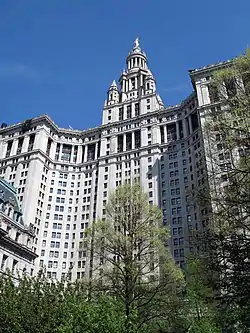| New York State Supreme Court Building | |
|---|---|
 New York State Supreme Court Building in 2013 | |
| Former names | New York County Courthouse |
| General information | |
| Location | 60 Centre Street New York, NY, United States |
| Coordinates | 40°42′51.2″N 74°0′5.5″W / 40.714222°N 74.001528°W |
| Current tenants | New York State Supreme Court New York County Clerk |
| Groundbreaking | 1919[1] |
| Opened | February 1927[1] |
| Owner | City of New York |
| Design and construction | |
| Architect(s) | Guy Lowell |
| Designated | February 1, 1966 (exterior)[2] March 24, 1981 (interior)[3] |
| Reference no. | 0083 (exterior)[2] 1124 (interior)[3] |
The New York State Supreme Court Building, originally known as the New York County Courthouse, at 60 Centre Street on Foley Square in the Civic Center neighborhood of Manhattan, New York City, houses the Civil and Appellate Terms of the New York State Supreme Court for the state's First Judicial District, which is coextensive with Manhattan, as well as the offices of the New York County Clerk.
The granite-faced hexagonal building was designed by Guy Lowell of Boston in classical Roman style and was built between 1913 and 1927, completion having been delayed by World War I. It replaced the former New York County Courthouse on Chambers Street, popularly known as the Tweed Courthouse. Both the interior and exterior are New York City Landmarks: the exterior was designated on February 1, 1966[4] and the interior on March 24, 1981.[5]
Site
The building is somewhat of an older sibling to Cass Gilbert's 1936 Corinthian-columned Foley Square Courthouse (renamed the Thurgood Marshall United States Courthouse in 2001) just to its south, which also faces Foley Square from the east. Both buildings face Federal Plaza across the square, which includes the more modern Jacob K. Javits Federal Building and James L. Watson Court of International Trade Building, which houses the U.S. Court of International Trade. Other court buildings are nearby, including those for New York City Criminal Court, New York City Civil Court, and the Surrogate's Courthouse.
Architecture
Exterior
The building's mass and scale give it the appearance of a temple. A broad set of steps sweeps up from Foley Square to a massive Corinthian colonnade covering most of the front of the courthouse, topped by an elaborate 140-foot-long (43 m) triangular pediment of thirteen figures carved in bas relief from granite. The pediment and acroteria by Frederick Warren Allen include three statues: Law, Truth, and Equity. A frieze bears the inscription "The true administration of justice is the firmest pillar of good government", a quotation taken from a letter written by George Washington to Attorney General Edmund Randolph on September 28, 1789.[6][7][8][9] The inscription is a slight misquote; Washington actually referred to the "due administration" of justice and not the "true administration" of justice, an error discovered by the New York Post in 2009.[10] The error was apparently made by the architect, Guy Lowell, and the mistake was repeated by others, including Charles Warren in his Pulitzer Prize–winning The Supreme Court in United States History (1922).[6]
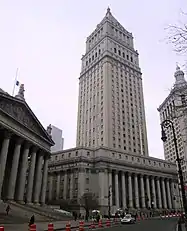
The stone steps leading up to the colonnaded entrance were flanked by two allegorical statues, Justice and Authority, both designed by the Franco-American sculptor Philip Martiny (1858–1927).[11][12] These are now at the back of the building.[13] Both are large seated figures made of granite.[12] On the right is Justice, a female figure holding a shield and scroll, while on the left is Authority, which holds a scroll and fasces, the Roman symbol of authority.[12] The figures were purchased by the City of New York in 1906 and originally flanked the Centre Street entrance to the Surrogate's Courthouse; they were removed in early 1960 for the widening of Centre Street and an expansion of the underlying platforms of the New York City Subway's Brooklyn Bridge–City Hall station and were then moved to the New York County Courthouse.[14]
.jpg.webp)
Interior
The rotunda is 200 feet (61 m) in circumference and rises 75 feet (23 m) to a cupola which in 30 feet (9.1 m) high and 20 feet (6.1 m) long. The rotunda also contains ten stained-glass windows and clerestory.[15] The rotunda's most striking feature, however, is the oft-reproduced circular mural Law Through the Ages,[16][17] also called The History of the Law.[15] This New Deal-era mural was designed by the Italian artist Attilio Pusterla and painted by him and a team of artists working under his direction from 1934 and 1936, under sponsorship from the Federal Art Project of the Works Project Administration.[9][15] Pusterla also executed murals in the courthouse's Jury Assembly Rooms on the fourth floor and Ceremonial Courtroom on the third floor.[15]
Law Through the Ages is divided into six lunettes, or sections.[15] Each depicts a pair of figures from historical cultures important to the history of law: Assyrian and Egyptian, Hebraic and Persian, Greek and Roman, Byzantine and Frankish, English and early colonial, with the final section portraying George Washington and Abraham Lincoln. Above the seated figures are portraits of six lawgivers: Hammurabi, Moses, Solon, Justinian, Blackstone and John Marshall.[5]
Restoration of the mural (along with a stained-glass window also by Pusterla) took place in 1988;[17] the project received a 1989 Design Award from the Public Design Commission of the City of New York.[18] The restoration project, which was privately funded by money raised from New York City judges and attorneys,[15][17] was part of a broader renovation campaign in the 1980s and 1990s to protect the courthouse's historic art from water seepage and other damage caused by neglect.[15]
History
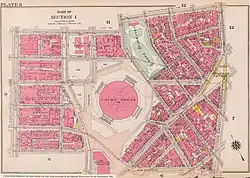
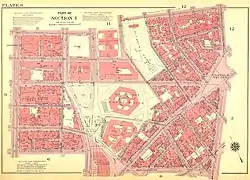
The architect was selected through a design competition, which Boston architect Guy Lowell won in 1913.[1] Lowell originally proposed a circular building, to be built at the vastly expensive sum of $20 to $30 million. Construction was delayed by World War I and the design was remade as a smaller and less expensive hexagonal building—a Temple of Justice.[1] The building was designed in the Roman classical style.[1] Work began in 1919.[1]
The courthouse's dedication ceremony took place in February 1927, two weeks after Lowell died.[1] Chief Judge of the New York Court of Appeals Benjamin Cardozo and Associate Judges of the Court of Appeals Frederick E. Crane and Irving Lehman were present at the event.[1]
In popular culture
Many films and television series have been shot at the New York County Courthouse.[19] These include:
- Miracle on 34th Street (1947): the scene of the trial of Santa Claus (Edmund Gwenn) was shot here; the 1994 remake filmed the courthouse's exterior[19]
- 12 Angry Men (1957)[19]
- The Defenders (1961-1965)
- The Godfather (1972)[19]
- Nuts (1987)[19]
- Legal Eagles (1986)[19]
- Wall Street (1987)[19]
- Goodfellas (1990)[19]
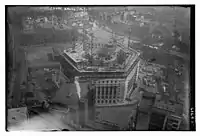
- Teenage Mutant Ninja Turtles (1990)
- Regarding Henry (1991)[19]
- Petrocelli, television series, during opening credits
- Night Court, television series
- Law & Order and its many spinoffs[19]
- Kojak
- Cagney & Lacey
- Damages
- Blue Bloods
- Bull, television series, end scene in season 2 episode 22
- Suits, television series
See also
References
- 1 2 3 4 5 6 7 8 Legal History and Architecture of New York County Supreme Courthouse, Historical Society of the Courts of the State of New York (accessed September 27, 2015).
- 1 2 "New York County Courthouse" (PDF). New York City Landmarks Preservation Commission. February 1, 1966.
- 1 2 "New York County Courthouse" (PDF). New York City Landmarks Preservation Commission. March 24, 1981.
- ↑ New York County Courthouse Designation Report, New York City Landmarks Preservation Commission (February 1, 1966)
- 1 2 New York County Courthouse Interior Designation Report Archived 2012-08-17 at the Wayback Machine, New York City Landmarks Preservation Commission (March 24, 1981). Accessed September 2, 2011.
- 1 2 Ben Zimmer, "When Typos are Set in Stone", Visual Thesaurus (February 18, 2009).
- ↑ "New York County Courthouse Pediment, New York Supreme Court, abt 1924" Archived 2012-03-30 at the Wayback Machine on the Frederick Warren Allen website
- ↑ Paul Goldberger, The City Observed: New York: A Guide to the Architecture of Manhattan. New York: Vintage Books, 1979, p. 34. ISBN 0-394-72916-1
- 1 2 "New York State Supreme Court Building", New York City Department of Citywide Administrative Services (accessed September 27, 2015).
- ↑ Golding, Bruce. "George Denied His Due", New York Post (February 16, 2009).
- ↑ Lucy D. Rosenfeld & Marina Harrison, Art on Sight: The Best Art Walks In and Near New York City (Countryman Press: 2013), pp. 32–33.
- 1 2 3 Marina Harrison & Lucy D. Rosenfeld. Artwalks in New York: Delightful Discoveries of Public Art and Gardens in Manhattan, Brooklyn, Queens, the Bronx, and Staten Island (NYU Press: 2004), pp. 23–24.
- ↑ "Authority and Justice: Philip Martiny". CultureNOWg. Retrieved February 25, 2018.
- ↑ Municipal Reference Library Notes, Volumes 35–36, Municipal Reference Library (1961), p. 142.
- 1 2 3 4 5 6 7 John F. Werner, The New York County Courthouse: A Brief Architectural/Design History (March 12, 2008). Material printed in conjunction with the talk "Circles and Hexagons upon a Square: Urbanism, Architecture and Civic Identity at 60 Centre Street" (March 12, 2008) by Jon Ritter, Assistant Professor in the Department of History at New York University.
- ↑ New York State Supreme Court, New York County - Civil Branch, Court Tours. Accessed April 12, 2011
- 1 2 3 William H. Honan, "From Walls and Halls, Art Heritage Emerges", The New York Times (April 18, 1988).
- ↑ "NYC Design: Eighth Annual Awards for Excellence in Design, June 8, 1989". NYC: The Official Website of the City of New York. Archived from the original on November 29, 2018. Retrieved July 27, 2019.
- 1 2 3 4 5 6 7 8 9 10 William A. Gordon, Shot on This Site: A Traveler's Guide to the Places and Locations Used to Film Famous Movies and TV Shows (Citadel Press, 1995), p. 209.
External links
 Media related to New York State Supreme Court 60 Centre Street at Wikimedia Commons
Media related to New York State Supreme Court 60 Centre Street at Wikimedia Commons
